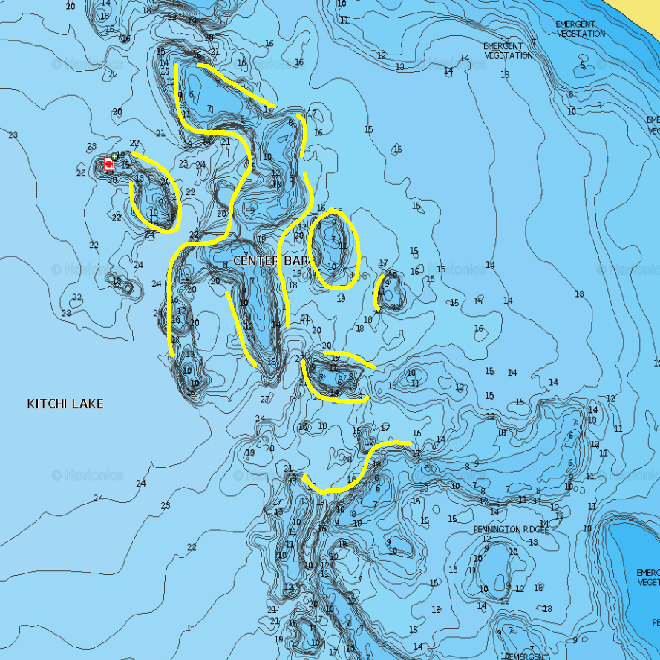
Located in the scenic Chippewa National Forest near the town of Cass Lake in north-central Minnesota’s Beltrami County, Kitchi Lake is part of the fabled Cass Lake Chain of lakes. At 1,758 acres, Kitchi is rich in structure and offers fine fishing for a variety of gamefish during the ice and open-water seasons.
Kitchi is one of several connected lakes joined via the Mississippi and Turtle rivers that comprise the Cass Lake chain of lakes. There is a limited amount of residential development along its lakeshore, although it is served by several resorts.
There is no developed public boat ramp on Kitchi Lake; however, boaters can access the lake by following the Turtle River upstream from the north side of Cass Lake.
Water levels in this system are affected by dam operations on the Mississippi River. Water level fluctuations can affect the growth of emergent and submerged vegetation as well as the availability of potential spawning habitats. In addition, fish populations in these connected waters are frequently influenced by fish movement between lakes. Walleye is the primary management species for Kitchi, and secondary management species include northern pike, black crappie, and muskellunge.
The longtime guide and Team Northland member Brian “Bro” Brosdahl of Bro’s Guide Service says this Northwoods gem is a favorite. “Kitchi is a great walleye, bass, and panfish destination,” he reports. “And as a bonus, the Pike Hole Bar and Restaurant located in the channel has a jaw-busting burger that’s perfect after a morning on the water.”
There is no developed public boat ramp on Kitchi Lake; however, boaters can access the lake by following the Turtle River upstream from the north side of Cass Lake. Brosdahl notes that Lost Acres Resort on Kitchi is a great place to access the lake.
Fishing Tactics
Brosdahl fishes Kitchi during the ice and open-water seasons. Depending on the time of year and conditions, he targets is abundant walleye population, slab-sided crappies, and “largely overlooked” largemouth bass.
1. In the fall, Brosdahl taps the walleye bite when hungry ’eyes rise from the depths to feed along rocky shorelines and the tops of hard-bottom humps. “Six to 12 feet of water is ideal in the fall,” he says. “There’s so much structure it’s hard to go wrong. The hard-bottom center humps with weeds on top, western shoreline, and steep breaks on the southwest shore are a few of the top areas to try.”
Brosdahl recommends dancing a jig this time of year. “Drifting and pitching a Northland RZ Jig or Fire-Ball Jig tipped with a rainbow or shiner minnow is hard to beat now,” he says. “Don’t rip it. Just pitch it out, let it hit bottom, give it a short lift and let it clunk back on bottom again.
“Another tactic that works wonders in the fall great is slow trolling or contour drifting with a Roach Rig with a minnow on it,” he adds.
2. Freeze-up doesn’t slow the action on Kitchi. “Morning and evening, the walleyes bite like clockwork on the edges of the humps,” Brosdahl explains. “They swim through, moving from hump to hump. The trick is to find a good ambush point to catch them as they pass through the area.”
When chasing Kitchi’s walleyes, favors a Buck-Shot Flutter Spoon during daylight hours and a Glow-Shot Spoon the last half hour before dark.
He cautions that walleye anglers may get a little lonesome. “Don’t be surprised if you’re the only person walleye fishing,” he laughs. “Most ice anglers go to Kitchi for the crappies. The deep holes hold fish averaging 9 to 11 inches, with the occasional 12- or 13-inches. Two of my favorite jigs here are a glow Bro’s Bling Jig or a Mud Bug with a few maggots on it.
3. Kitchi serves up multi-species action in the spring, starting with crappies. “There’s a very good crappie bite on the weedlines in spring to early summer,” he says. “Try hard-bottom points that have bulrushes and maidencane. This is a great place to throw a Firefly or Gypsi Jig under a Lite-Bite bobber. Don’t forget Thumper heads, either, and don’t be surprised to catch walleyes right in with the crappies.
“Spring walleye fishing can be phenomenal on Kitchi,” he continues. “Walleyes move in from all over the Cass Lake Chain. Fish a Fire-Ball Jig tipped with a spottail shiner in the river mouths and along shoreline-connected points. The south end of the lake, where it necks down to Pug Hole, is a great morning and evening spot.”
4. Come summer, many walleyes head for the salad bar. “The fish go to the weeds,” Brosdahl says. “To catch them, fish the edges of the weeds with a Rock-Runner Bottom Bouncer and Rainbow Spinner with a crawler or a leech. Fishing the same baits on a Gum-Drop Floater behind a bouncer is also a smart play.”
This is also the season when Brosdahl breaks out the bass tackle. “Largemouths are the lake’s best-kept secrets,” he says. “Fish Reed-Runner Spinnerbaits, IMPULSE tubes, and IMPULSE Dip-Stick Worms along the heavy weedlines and inside cuts to shore. Because of the stained water, Kitchi is a great place to bust bass, walleyes, and panfish on bright sunny days when fish in clearer waters play hard to catch.”
Vital Stats
Kitchi Lake
Surface Area: 1,758 acres
Maximum Depth: 50 feet
Average Water Clarity 4 feet
Shoreline: 14.21 miles
Fish Species Present: black bullhead, black crappie, bluegill, brown bullhead, burbot, hybrid sunfish, lake whitefish, largemouth bass, muskellunge, northern pike, pumpkinseed, rock bass, tullibee (cisco), walleye, yellow bullhead, yellow perch, bowfin (dogfish), redhorse, river redhorse, shorthead redhorse, white sucker, common shiner.

